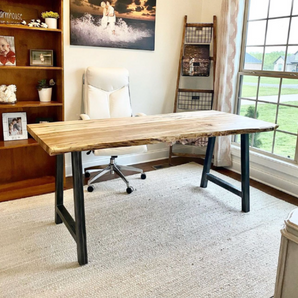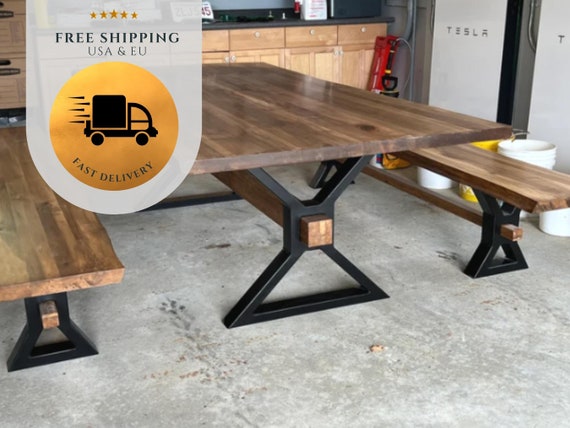Dining Room Table Legs That Integrate Performance and Modern Layout
Dining Room Table Legs That Integrate Performance and Modern Layout
Blog Article
A Comprehensive Take A Look At Table Leg Styles: Finding the Ideal Match
Choosing the ideal eating table leg design is important for both visual appeal and practical functionality. For those with bigger tables, trestle legs make sure durable support, whereas barrette legs introduce a mid-century contemporary vibe with their minimalist layout. The x-shaped legs mix contemporary design with boosted stability.
Standard Four Legs
Among the various sorts of table leg designs, the traditional four-leg style continues to be a timeless option for many houses. This timeless setup provides a harmonious mix of capability and aesthetic appeals, making it a seasonal fave. Four legs offer balanced support, making certain the table continues to be stable and efficient in birthing substantial weight. This is particularly useful for households that regularly organize large gatherings or use their table for numerous purposes, such as work or crafting.
From a visual point of view, the standard four-leg design can be quickly adjusted to various interior styles. Whether crafted from timber, metal, or a mix of materials, these legs can be intricately carved, streamlined and minimalistic, or anything in between. Their versatility enables them to enhance both rustic and modern setups perfectly.
Furthermore, the straightforward structure of the four-leg layout assists in convenience of activity and positioning within an area. Unlike more complicated bases, this style reduces blockages, offering enough legroom for diners. In recap, the standard four-leg eating table leg design weds enduring style with functional functionality, making it a sharp option for those looking for both kind and feature in their eating furniture.
Stand Base
Frequently celebrated for its sophisticated and space-efficient layout, the stand base is a recognized choice to the conventional four-leg arrangement in table leg designs. This distinct base normally includes a single main column sustaining the table top, which can differ in kind, from ornately carved wood to streamlined, modern steel. Among the primary benefits of the stand base is its capability to maximize legroom and seating versatility. Without edge legs, diners are paid for better flexibility of motion, making it a suitable selection for round and oblong tables that promote even more intimate and inclusive events.
In addition, the pedestal base's central support can manage substantial weight, permitting making use of larger tabletops, such as marble or thick hardwood. This toughness coupled with its visual adaptability makes the pedestal base a popular option in both standard and modern indoor settings. It can perfectly integrate with various layout styles, from traditional style to minimal modernity. The main column itself supplies a canvas for detailed styles and artistic expressions, including an element of aesthetic rate of interest under the table. In recap, the stand base integrates functionality with style, making it a fine-tuned and sensible alternative for diverse dining environments.
Trestle Legs
Trestle legs give a robust and classic foundation for eating tables, defined by their horizontal cross-bracing and durable assistance light beams. Stemming from middle ages times, this style has actually advanced yet preserved its important framework, making it a seasonal favorite in both standard and modern settings. The main trestle beam, usually sustained by 2 or even more upright messages, provides phenomenal stability, enabling bigger table lengths without the need for added legs.
A considerable benefit of trestle leg tables is the adequate legroom they supply. Unlike tables with 4 edge legs, the lack of obstructions at the table's edges gives unblocked space for chairs and restaurants, improving comfort and availability. This makes trestle tables ideal for fitting larger gatherings, whether in a dining-room or a reception hall.
From rustic farmhouse to sleek modern designs, trestle legs can be personalized to fit specific tastes. Their long-lasting charm and practical benefits make trestle legs an engaging selection for those looking for both design and functionality in their eating table.
Hairpin Legs

The appeal of barrette legs depends on their simplicity and convenience - dining room table legs. Available in a variety of products, consisting of steel and brass, they can be explanation completed in various colors to enhance different interior designs. Whether matched with a rustic wooden tabletop or a modern glass surface area, hairpin legs effortlessly blend performance with a touch of vintage appeal
Sturdiness is one more remarkable feature of hairpin legs. Regardless of their delicate look, these legs are crafted to bear substantial weight, ensuring the eating table stays steady and secure. In addition, they are relatively easy to set up, making them a preferred choice for do it yourself lovers and specialist furniture manufacturers alike.
X-Shaped Legs

Created from products such as steel, timber, or a mix of both, X-shaped legs can be tailored to match numerous design choices. Steel legs often offer a smooth and industrial feeling, perfect for loft-style houses and contemporary pop over to this site dining areas. On the other hand, wood X-shaped legs offer a warmer, extra rustic appeal, ideal for farmhouse or diverse interiors. The flexibility in products enables house owners to customize their dining tables to much better fit their total design plan.
In addition, the design behind X-shaped legs guarantees also weight circulation, decreasing the risk of wobbling and boosting durability. This makes them particularly appropriate for bigger dining tables that require added assistance. In significance, X-shaped legs blend practical engineering with modern visual appeals, making them a classic selection for diverse dining environments.
Final Thought
A thorough understanding of eating table leg styles exposes the distinct qualities and advantages of each design. Trestle legs make certain robust support for bigger tables, click for more info and hairpin legs introduce a mid-century contemporary aesthetic.
Report this page